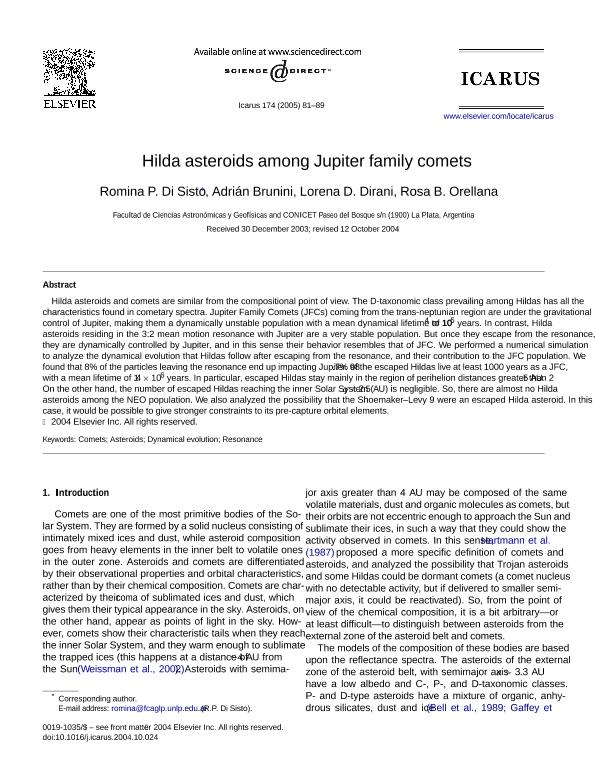Artículo
Hilda Asteroids among the Jupiter Family Comets population
Fecha de publicación:
12/2005
Editorial:
Academic Press Inc Elsevier Science
Revista:
Icarus
ISSN:
0019-1035
Idioma:
Inglés
Tipo de recurso:
Artículo publicado
Clasificación temática:
Resumen
Hilda asteroids and comets are similar from the compositional point of view. The D-taxonomic class prevailing among Hildas has all the characteristics found in cometary spectra. Jupiter Family Comets (JFCs) coming from the trans-neptunian region are under the gravitational control of Jupiter, making them a dynamically unstable population with a mean dynamical lifetime of 104 to 105 years. In contrast, Hilda asteroids residing in the 3:2 mean motion resonance with Jupiter are a very stable population. But once they escape from the resonance, they are dynamically controlled by Jupiter, and in this sense their behavior resembles that of JFC. We performed a numerical simulation to analyze the dynamical evolution that Hildas follow after escaping from the resonance, and their contribution to the JFC population. We found that 8% of the particles leaving the resonance end up impacting Jupiter. 98.7% of the escaped Hildas live at least 1000 years as a JFC, with a mean lifetime of 1.4 × 106 years. In particular, escaped Hildas stay mainly in the region of perihelion distances greater than 2.5 AU. On the other hand, the number of escaped Hildas reaching the inner Solar System (q < 2.5 AU) is negligible. So, there are almost no Hilda asteroids among the NEO population. We also analyzed the possibility that the Shoemaker–Levy 9 were an escaped Hilda asteroid. In this case, it would be possible to give stronger constraints to its pre-capture orbital elements.
Palabras clave:
Comets
,
Asteroids
,
Dynamical Evolution
,
Resonance
Archivos asociados
Licencia
Identificadores
Colecciones
Articulos(IALP)
Articulos de INST.DE ASTROFISICA LA PLATA
Articulos de INST.DE ASTROFISICA LA PLATA
Citación
Di Sisto, Romina Paula; Brunini, Adrian; Dirani, Lorena Daniela; Orellana, Rosa Beatriz; Hilda Asteroids among the Jupiter Family Comets population; Academic Press Inc Elsevier Science; Icarus; 174; 12-2005; 81-89
Compartir
Altmétricas




